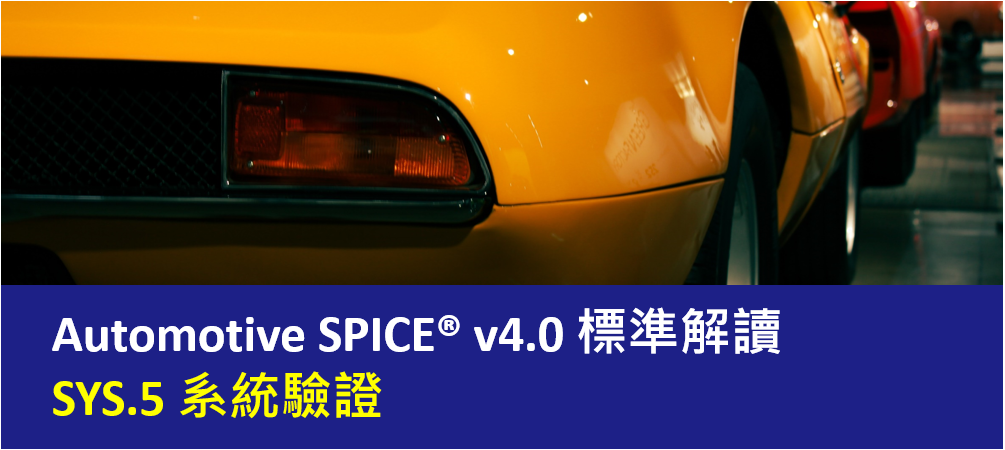本流程為ASPICE v4.0標準中的系統工程流程 — SYS.5 System Verification 系統驗證;本文章為「ASPICE v4.0 標準解讀」系列文章,筆者將針對ASPICE標準條文提供解讀與說明,期許本篇文章能夠為讀者,解決標準導入時的疑惑。
流程目的(Process Purpose)
The purpose is to ensure that the system is verified to be consistent with the system requirements.
本流程的目的是整合系統元件並驗證整合後的系統元件與系統架構相一致。
流程結果(Process Outcome)
成功實作本流程,其相應的結果如下:[Outcome 1] 針對系統架構 (包括系統元件間的介面和互動),明定系統元件整合驗證的驗證措施[Outcome 2] 將系統元件整合成符合發佈範圍的完整整合系統[Outcome 3] 根據發佈範圍,選擇了驗證措施,考慮回歸驗證的標準[Outcome 4] 使用選定的驗證措施驗證整合系統元件,並記錄系統整合驗證的結果[Outcome 5] 在驗證措施和系統架構元件之間建立一致性和雙向追溯性[Outcome 6] 建立驗證結果和驗證措施之間的雙向追溯性[Outcome 7] 將系統整合和整合驗證的結果總結並通知所有受影響的各方
基礎實踐(Base Practices)
SYS.5.BP1: Specify verification measures for system verification.
SYS.5.BP1: 指定系統驗證的驗證措施
Specify the verification measures for system verification suitable to provide evidence for compliance with the functional and non-functional information in the system requirements, including
- Techniques for the verification measures
- Pass/Fail criteria for verification measures
- A definition of entry and exit criteria for the verification measures
- Necessary sequence of verification measures
- The required verification infrastructure and environment setup
指定系統驗證的驗證措施,該驗證措施適合提供證據以驗證系統要求中功能性和非功能性資訊。驗證措施包含以下內容:
- 驗證措施的技術
- 驗證措施的通過/不通過標準
- 驗證措施的進入和退出標準的定義
- 驗證措施的必要順序
- 所需的驗證基礎設施和環境設定
NOTE 1: The system verification measures may cover aspects such as thermal, environmental, robustness/lifetime, and EMC.
備註1: 系統驗證措施可能涵蓋熱性、環境、穩健性/壽命和電磁兼容性(EMC)等方面
額外說明 -- 關於驗證策略與回歸驗證策略 ASPICE v4.0中,明確的將「制定策略」從既有的BP移除。這些關於策略制定的部分,將會在CL2認證時,才需要詳細定義。換句話說,如果專案要取得CL1認證,將不需要撰寫或定義任何策略。
額外說明 -- 驗證措施的必要順序 在系統驗證流程時,待測物通常是已整合完成之產品,因此,這個階段的驗證通常包含一般性的功能測試,以及品質相關的驗證 (包含耐熱、環境、EMC、...)、其他需要長時間的驗證、或需要用到特殊設備的驗證。這些驗證方法,有些會是由專案團隊來執行,有些則需要交由外部的實驗室來進行。 因此,在驗證措施的執行順序,要特別考慮到上述各種的驗證方法 (包含相依性)。
額外說明 -- 其他補充 「Verification」的補充講解,請參考 SYS.4 額外說明: 驗證措施 驗證措施的內容,請參考 SYS.4 額外說明: 驗證措施應包含的內容 驗證措施的進入與退出條件,請參考 SYS.4 額外說明: 驗證措施的進入與退出條件
—
SYS.5.BP2: Select verification measures.
SYS.5.BP2: 選擇驗證措施
Document the selection of verification measures considering selection criteria including criteria for regression verification. The selection of verification measures shall have sufficient coverage according to the release scope.
根據驗證措施選擇準則(包括回歸驗證準則),記錄驗證措施的選擇。驗證措施的選擇應根據釋出範圍具備足夠的覆蓋率。
NOTE 2: Examples for selection criteria can be prioritization of requirements, the need for regression verification (due to e.g. changes to the system architectural design or to system components), or the intended use of the delivered product release (e.g. test bench, test track, public road etc.)
備註2: 舉例來說,選擇準則可以包括需求的優先順序、需要回歸驗證(例如: 由於系統架構設計或系統元件的更改)或所交付產品發布的預期用途(例如: 測試台、測試場地、公共道路等)。
額外說明 -- 回歸驗證策略 一般來說,回歸策略的應用時機跟「變更」有關,變更可以是針對實作,亦可以是針對規格。當變更發生時,測試人員可以根據回歸策略選擇適當的測試案例,進行測試。 系統驗證流程的回歸驗證策略,屬於「需求類型」的回歸。這類型的回歸策略,可以根據需求與需求之間的邏輯分組及相依特性來進行選擇。 請參考下圖案例。 系統驗證階段結束,所有測試案例均被測試,其中TestCase_001_01結果為FAIL。經過工程人員修正後,決定要重新執行測試。這個時候,測試範圍的選擇可以根據不同的回歸驗證策略來決定。 針對每間公司對於測試的品質要求,回歸驗證策略可以再有更多的變化可能。筆者先針對比較常見的回歸策略,提供不同的重測範圍以供參考。 範圍1: 哪個案例錯,就重測哪個 (紅色) 範圍2: 選擇該需求的所有測試案例 (藍色) 範圍3: 選擇該需求群組的所有測試案例 (綠色) 範圍4: 選擇該需求群組 + 需求相依的所有測試案例 (綠色) + (橘色) 範圍5: 所有的測試案例
—
SYS.5.BP3: Perform verification of the integrated system.
SYS.5.BP3: 執行整合系統的驗證
Perform the verification of the integrated system using the selected verification measures. Record the verification results including pass/fail status and corresponding verification measure data.
使用選定的驗證措施執行整合系統的驗證。記錄驗證結果,包括通過/不通過的狀態以及相應的驗證措施資料。
NOTE 3: See SUP.9 for handling verification results that deviate from expected results.
備註3: 請參閱SUP.9,以處理偏離預期結果的驗證結果。
—
SYS.5.BP4: Ensure consistency and establish bidirectional traceability.
SYS.5.BP4: 確保一致性並建立雙向追溯
Ensure consistency and establish bidirectional traceability between verification measures and system requirements. Establish bidirectional traceability between verification results and verification measures.
在驗證措施和系統需求之間確保一致性並建立雙向追溯。
建立驗證結果與驗證措施之間的雙向追溯。
NOTE 4: Bidirectional traceability supports consistency, and facilitates impact analysis of change requests, and demonstration of verification coverage.
備註4: 雙向追溯可以用來支援一致性、協助變更請求的影響分析、並支援展示對利益相關者需求的範圍覆蓋。
額外說明 -- 追溯的細節 有關於SYS.5的追溯及一致性,請參考下圖。
—
SYS.5.BP5: Summarize and communicate results.
SYS.5.BP5: 總結並傳達結果
Summarize the system verification results and communicate them to all affected parties.
總結系統驗證結果,並將其傳達給所有受影響的各方。
NOTE 5: Providing all necessary information from the test case execution in a summary enables other parties to judge the consequences.
備註5: 從測試案例執行中提供所有必要的資訊摘要,使其他各方能夠判斷後果。
輸出資訊項目(Output Information Item)
08–60 驗證措施08–58 驗證措施選擇結果15–52 驗證結果13–51 一致性證據13–52 溝通證據
